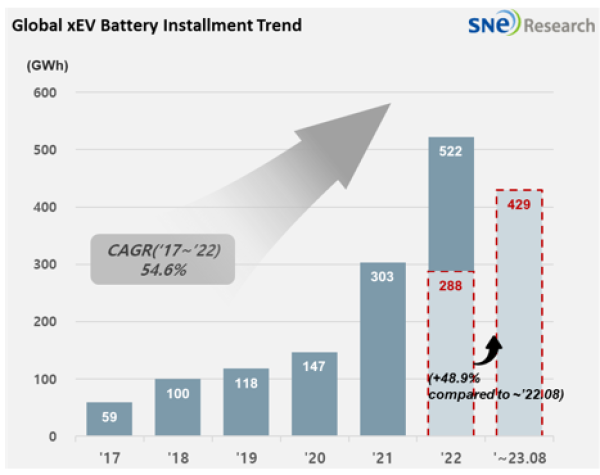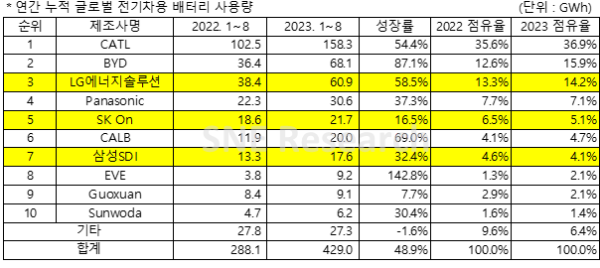On 11 October, global information agency SNE Research released the latest data on global power battery loading.
From January to August 2023, the global power battery installed volume was 429GWH, up 48.9% year-on-year. Six Chinese battery companies were named in the top ten, with an overall market share of 63.1%, a significant increase of 5 percentage points from 58.1% in the same period last year. The combined market share of the three South Korean companies was 23.4%, down 1 percentage point from the same period last year. As the only Japanese company in the top ten, Panasonic Japan's market share fell by 0.6 percentage points year-on-year.

Among them, CATL continued to show absolute dominance, and from January to August, the overall installed battery volume of CATL exceeded that of second-place BYD by two times and also exceeded that of the three South Korean companies plus Panasonic of Japan combined. In addition, compared with January-July, the market share gap between CATL and BYD widened by 1 percentage point to 21 percentage points.
SNE research noted that the growth trend in battery installations of the three major South Korean companies was mainly influenced by strong sales of battery-equipped electric vehicle models of each company. LG New Energy had the fastest growth rate in installed capacity among the three Korean companies, driven by good sales of global bestsellers such as the Tesla Model 3/Y, Volkswagen ID 3/4, and Ford Mustang Mach-E.

Samsung SDI maintained its growth momentum with continued sales of the BMW i4/i7/iX, Audi Q8 E-Tron, Rivian R1T/R1S/EDV, and Fiat 500, while SK On grew with steady sales of the Hyundai IONIQ5, Kia EV6, and Mercedes EQA/B.
As the only Japanese company in the top 10, Panasonic is one of Tesla's main battery suppliers, with the majority of its batteries loaded into Tesla models for the North American market. Among other things, Tesla Model Y sales rose sharply year-on-year, pulling Panasonic's growth. In addition, Mazda's vehicles are also equipped with Panasonic batteries, and the two companies are discussing matters related to expanding supply in the future.
According to SNE research, the growth rate of global electric vehicle sales has been slowing down recently. Vehicle prices are thought to be the main reason for the slowdown, and the market for cost-effective entry-level EVs is heating up. To reduce the cost of batteries, which account for the highest proportion of the cost of electric vehicles, more and more companies are beginning to use lithium iron phosphate batteries, which are more price-competitive than lithium ternary batteries.
It is reported that with the increase in demand for Lifepo4 Battery for electric vehicles, three Korean companies that previously developed high-performance lithium ternary batteries are also expanding the development of batteries for entry-level electric vehicles.
For example, at the Munich Motor Show in Germany in September, South Korea's Samsung SDI launched its latest lithium manganese iron phosphate battery products. According to LG New Energy's semiannual report this year, LG New Energy plans to set up a 4680 cylindrical production line at its Wukang plant in South Korea and convert part of the production line at its Nanjing plant in China to a lithium iron phosphate production line within the year. At the same time, LG New Energy will also improve the competitiveness of products in market segments, including high-voltage medium-nickel (mid-Ni), manganese-rich, and lithium iron phosphate batteries.
In addition, SNE research pointed out that by the United States "Inflation Reduction Act" (IRA), countries have begun to raise trade barriers, in this case, the three South Korean companies are promoting the lithium iron phosphate battery strategy, the future will make its market share of how to change is of great concern.
Next:Revolutionizing Energy Storage: Higee's 314Ah High-Capacity Cells
Previous:BAK Power Battery Unveils Semisolid-State Battery Line